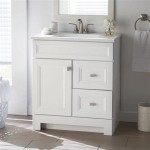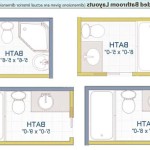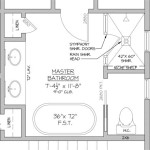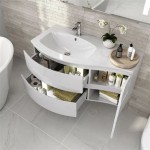Should Bathrooms Be Light Or Dark? Exploring the Aesthetics and Functionality of Bathroom Lighting
The design of a bathroom involves a complex interplay of aesthetics and functionality. One of the most crucial elements influencing both is the choice of lighting scheme. Traditionally, bathrooms were predominantly designed with light and airy palettes, emphasizing cleanliness and practicality. However, in recent years, darker, moodier bathroom designs have gained popularity, offering a sense of luxury and relaxation. The decision of whether a bathroom should be light or dark is not merely a matter of personal preference; it's a multifaceted consideration dependent on factors such as room size, natural light availability, intended use, and desired atmosphere.
The following exploration examines the advantages and disadvantages of both light and dark bathroom designs, providing a comprehensive overview to inform the design process. This analysis will delve into the practical implications, the psychological impact, and the stylistic considerations associated with each approach, enabling a more informed and nuanced understanding of the lighting choices best suited for different bathroom environments.
The Case for Light Bathrooms: Brightness, Space, and Functionality
Light bathrooms are often associated with cleanliness and hygiene. A bright, well-lit space allows for easy identification of dirt and grime, promoting more thorough cleaning practices. This is particularly important in a room where hygiene is paramount. Light colors, especially white and light pastels, reflect light effectively, making even smaller bathrooms appear larger and more open. This is achieved by minimizing shadows and creating a sense of visual expansion.
Functionality is a key benefit of light bathrooms. Tasks such as applying makeup, shaving, and grooming require ample light for precision and accuracy. A bright, even lighting scheme ensures that these activities can be performed safely and effectively, reducing the risk of mistakes or injuries. Furthermore, light colors tend to be more versatile and can easily complement a wide range of fixtures and accessories, offering greater flexibility in design choices. The neutral canvas provided by a light bathroom allows for the introduction of pops of color through towels, artwork, or plants, enabling easy updates and style changes without requiring a complete renovation.
Beyond the practical advantages, light bathrooms can also have a positive psychological impact. Bright spaces are often associated with feelings of energy, optimism, and well-being. A light and airy bathroom can therefore create a refreshing and invigorating atmosphere, perfect for starting the day or preparing for bed. The increased natural light, further enhanced by light color schemes, can also contribute to improved mood and reduced feelings of stress or confinement. This is particularly relevant in climates with limited sunlight, where a bright bathroom can help to combat seasonal affective disorder (SAD).
However, light bathrooms are not without their drawbacks. Overly bright lighting can be harsh and unflattering, particularly in cases where artificial light is the primary source. Improperly placed light fixtures can create glare and shadows, leading to eye strain and discomfort. Furthermore, maintaining a light bathroom requires diligent cleaning to prevent stains and discoloration from becoming noticeable. Light surfaces tend to show dirt and grime more easily, necessitating more frequent cleaning to maintain a pristine appearance. The perceived cleanliness can be compromised if upkeep is neglected. The minimalist aesthetic, while often appealing, can also feel sterile or impersonal if not carefully balanced with warm textures and personal touches.
The Appeal of Dark Bathrooms: Luxury, Relaxation, and Drama
Dark bathrooms evoke a sense of luxury, sophistication, and drama. Dark colors, such as deep blues, grays, and blacks, create a rich and opulent atmosphere, often associated with high-end spas and hotels. This approach rejects the traditional emphasis on stark cleanliness and embraces a more intimate and indulgent aesthetic. Dark bathrooms can be particularly effective in creating a relaxing and calming environment, perfect for unwinding after a long day. The subdued lighting and darker hues can reduce stimulation and promote feelings of tranquility and restfullness.
One of the key advantages of dark bathrooms is their ability to conceal imperfections. Dark surfaces are more forgiving when it comes to hiding stains, watermarks, and minor blemishes. This can be particularly beneficial in high-traffic bathrooms where frequent spills and splashes are inevitable. The use of textured materials, such as dark wood, stone, or tile, can further enhance this effect, adding depth and visual interest while masking any irregularities. Dark bathrooms offer designers the opportunity to experiment with different lighting techniques to create a dramatic and evocative atmosphere. Accent lighting, such as spotlights or sconces, can be used to highlight specific features, such as artwork, decorative tiles, or luxurious fixtures.
Moreover, dark bathrooms can be surprisingly energy-efficient. By incorporating dimmer switches and strategically placed lighting fixtures, it's possible to create a warm and inviting ambiance without relying on excessive illumination. This can lead to significant energy savings over time. The contrast between dark walls and bright accents can also be visually striking, creating a sense of depth and dimension. This contrast can be achieved through the use of metallic finishes, such as gold, brass, or copper, which reflect light and add a touch of glamour to the space. The bold, dramatic aesthetic of dark bathrooms can be a powerful statement, reflecting a confident and sophisticated design sensibility.
However, dark bathrooms present their own set of challenges. Dark colors absorb light, which can make smaller bathrooms feel even more cramped and claustrophobic. This is particularly true if the bathroom lacks sufficient natural light. Careful planning is essential to ensure adequate illumination and prevent the space from feeling gloomy or oppressive. The selection of lighting fixtures is crucial in a dark bathroom design. Overly harsh or bright lighting can create glare and disrupt the overall aesthetic. Dimmer switches are essential to allow for adjustments based on personal preference and the time of day.
Furthermore, dark bathrooms can be more difficult to clean thoroughly. While dark surfaces may conceal imperfections, they can also make it harder to spot dirt and grime. Regular cleaning is essential to maintain a hygienic environment. The dramatic aesthetic of dark bathrooms may not appeal to everyone. Some individuals may find the dark colors to be depressing or overwhelming. This is particularly true for those who prefer a more traditional or minimalist design style. Careful consideration should be given to personal preferences and the overall design aesthetic of the home before opting for a dark bathroom.
Factors Influencing the Decision: Size, Light Availability, and Intended Use
The size of the bathroom is a major determinant in deciding whether to opt for a light or dark design. In small bathrooms, light colors are generally preferred as they create the illusion of space and prevent the room from feeling cramped. Dark colors, on the other hand, can make a small bathroom feel even smaller and more enclosed. However, in larger bathrooms, dark colors can be used more effectively to create a sense of intimacy and luxury. The larger space can accommodate the darker hues without feeling oppressive. In larger bathrooms, one can also add more lightings to brighten the place.
The availability of natural light is another crucial factor to consider. Bathrooms with ample natural light can often accommodate darker colors without feeling gloomy. The natural light helps to balance the darkness and create a more welcoming atmosphere. However, bathrooms with limited or no natural light may benefit more from a light color scheme to maximize the available light and prevent the room from feeling dark and depressing. In the absence of natural light, high-quality artificial lighting is essential to ensure adequate illumination.
The intended use of the bathroom should also influence the design choices. Bathrooms that are primarily used for functional purposes, such as showering and grooming, may benefit more from a light and bright design. This enhances visibility and makes it easier to perform these tasks safely and effectively. Bathrooms that are intended for relaxation and indulgence, such as master bathrooms or spa-like retreats, may be better suited for a darker, more subdued design. This creates a calming and tranquil atmosphere, perfect for unwinding after a long day. For example, a guest bathroom may be designed with lighter colors and brighter lighting as it is used for functional tasks such as quick showers and make up. A master bedroom bathroom may be designed darker and with warmer lighting to add a spa like feeling.
Ultimately, the decision of whether a bathroom should be light or dark is a personal one. There is no right or wrong answer. The best approach depends on individual preferences, the specific characteristics of the bathroom, and the desired atmosphere. It is crucial to carefully consider all of the factors outlined above before making a decision. Experimentation with different color palettes, lighting techniques, and materials can help to determine the most suitable design for each individual bathroom.

Which Is Better For Your Luxurious Bathroom Dark Tiles Or Light

Choosing A Light Or Dark Bathroom Colour Scheme For Small Space

How To Light Up A Dark Bathroom
Tips For Brightening A Dark Bathroom Rockform

38 Dark Bathroom Ideas Industrial Inner City Modern And More

What Color Should I Paint My Bathroom How To Choose The Best Colors

Choosing A Light Or Dark Bathroom Colour Scheme For Small Space

Bathroom Colors For Bathrooms Without Natural Light Forbes Home

What Would You Choose Dark Or Light Tile Floors

Can T Decide On Light Or Dark Floor In Bathroom Houzz
Related Posts







